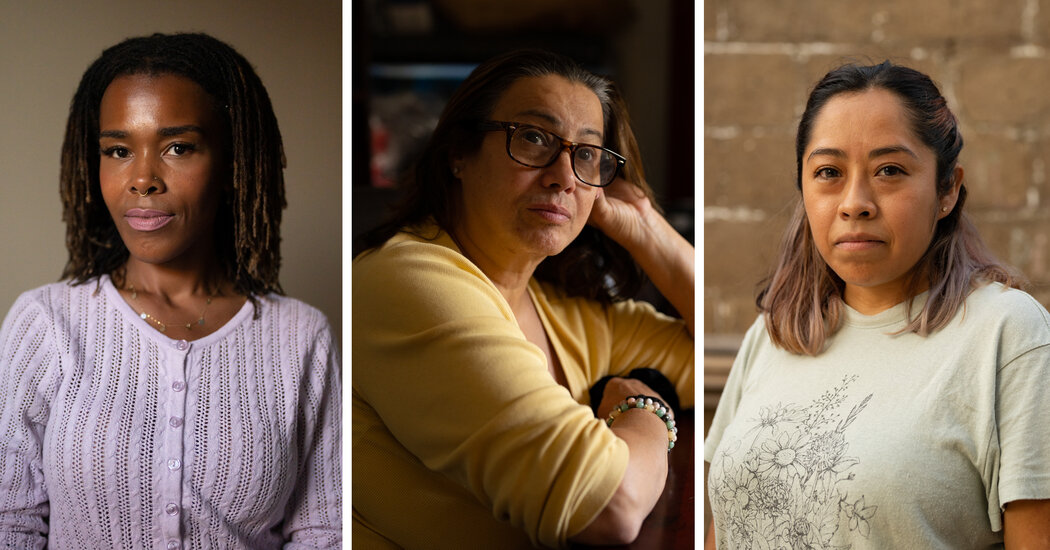The RealReal’s CEO on Turning the Luxury Resale Company Around
John Koryl spent his first months as chief executive of the RealReal helping to clean out customers’ closets. The company had recently changed its consignment policy for the luxury goods it offered, and Mr. Koryl wanted to see how people were reacting to it. So he traveled to people’s homes in Orange County, Calif., Long Island and elsewhere to find out what he couldn’t glean from his office.
In Mr. Koryl’s telling, he’s the “guy who folds things and packs the bags because that’s about all the value — other than listening — that I add.”
He brings an affable, disarming quality to his work. But his job now is exceedingly crucial: He is responsible for turning around a flailing business.
The RealReal is fueled by customers selling their expensive wares to the company; the company in turn authenticates the goods and puts them on its site or in one of its 25 shops and consignment stores, from Manhattan to Dallas and West Hollywood. When the item sells, the consignor receives a commission. (If the item doesn’t sell within a year, it is either returned to the consignor or donated to charity.) The e-commerce reseller was founded over a decade ago, and not long afterward people began to ask lofty questions about whether this San Francisco start-up could save retail.
But since going public in June 2019, its stock has declined 92 percent. As the luxury resale market continues to grow, the RealReal has struggled with inventory and other issues. The company changed policies to the disgruntlement of some customers, and it has conducted two rounds of layoffs this year.
Mr. Koryl said he was focusing on better understanding the RealReal’s customer — and finding even more people willing to consign their Hermes bags and 14-karat-gold diamond necklaces. He called 2023 the RealReal’s “reset year.”
He sat down with The New York Times, a few days after the company reported a $41 million loss for the quarter through July, to discuss how he was trying to give the RealReal a new look, what it was like to follow in the footsteps of a chief executive who was the founder and the item he would immediately purchase if he saw it on the site.
This interview was condensed and edited for clarity.
You are coming after a C.E.O. who was also the founder, so that’s always an adjustment for any company in any industry. I think often there’s that feeling of “how do I make my mark because obviously the founder made theirs.” So what’s the biggest change that you’ve made in your first six months?
I think it’s having a lot of respect for what has been done. I realized I walked into a room of a bunch of pioneers — and female-led pioneers at that — with a sustainability vision in mind. How often do you get that opportunity? So you have to tread very lightly. You have to have a lot of respect for what made them the company that you wanted to join.
When the RealReal was founded in 2011, the idea of consigning luxury goods without diluting the brand was a novel one for both shoppers and investors. The company’s stock has taken a hit since its I.P.O. as investors seem to be finally wanting a return on investment and see a more firm timeline for reaching profitability.
What does that mean for you? And how are you trying to position the business now that its model is no longer the new idea?
I think, in many ways, the goal posts moved on the RealReal. At the I.P.O., everybody was being rewarded for endless growth. As long as the revenue was growing 30 percent or more, you were being rewarded by Wall Street. And then Covid happened. The world said, “No, no, no, we want everybody to be profitable.”
Part of the reason I’m here is to turn that story around where we can actually continue to grow double digits. Definitely not at the same 35 percent to 40 percent pace of the past, but we can grow double digits and we can grow a profitable business.
How will you do that?
We’ve gotten out of direct buy merchandise [purchasing the merchandise outright and storing it]. We’ve really minimized the amount of merchandise under $100 that we have on the site. We’ve really tightened our belts in terms of the cost profile. We have to address our debt overhang.
In November, the RealReal overhauled its consignment policies, which includes no longer accepting merchandise under $100 as the company focuses on acquiring items that provide higher margins; limiting direct buys; and offering lower commissions for lower-priced items. What did you learn from that process?
We had a little bit of a reaction when we changed our commission structure last November. People started getting their first checks in January and February, and they weren’t signing with us as much. It was because the commission changes were a little too abrupt and too much at one-time. So we’re doing more of the personalized approach.
As long as we can keep that supply growing, we can keep the double-digit growth of our traditional business and we can complement it with these other businesses, we think we will meet Wall Street’s new expectation that companies like this need to be profitable.
Yes, there is a lot of very worthy competitors playing at similar price points, similar categories. But has anybody done it across all the brands? And with the consistency and convenience that we have? That’s the moat that we have to protect, and we have to meet his or her expectations every day. That’s what we’re striving to do.
A turnaround is often needed because a company has expanded too far beyond its core customer. Is that how you see what happened with the RealReal?
It’s a little bit of tweaking more than pulling back. With our current capabilities and the current business model we have, we can’t operate well and profitably with less than $100 merchandise. We also found categories that honestly we weren’t very good at — we extended into memorabilia, we extended into art and home, we extended into kids — and we had to pare back. Honestly, they’re, for the most part, gone.
The reality is, we’re absolutely at our best with jewelry, watches, ready-to-wear, handbags, shoes.
When you were talking to customers, what was the biggest frustration they had about the RealReal that surprised you?
I think it’s all around education of what we do and don’t take. And the understanding of how we arrive at a price.
In the past, it would have been: “You’ve lost too many goods. I’ve gotten burned. What happened to this?” Or: “It’s taking too long for the merchandise to get onto the site.”
A lot of those have gone away for the most part. Now, it’s really, “You used to take this designer, you won’t anymore. Why won’t you?” In a perfect world, we’d say, “OK, we will take everything.” But there’s an economic reality, right?
I’ll give you an example. Certain brands of jeans we used to be able to sell for over $100. Now you just can’t get the same return for them. So instead of upsetting you by us taking them and selling them for way less than you want, we’re just telling you now we don’t take them.
What’s the plan for the RealReal to use artificial intelligence?
The first was authenticating the merchandise. The second was pricing the merchandise. Where we’re spending more time now is where can we, at intake, start with a picture of a good and right there we can say, “Have we seen this good before?” “I already recognize that pattern, so now I don’t have to write all the copy. I don’t have to take all the measurements unless we perceive that it’s been altered.”
It still needs to go through authentication, but we can send it down a different lane where instead of each piece that we receive being a one-off, now all of a sudden we’re starting to batch things together. We can do those kinds of things and reduce operational costs.
Dupes have become a bigger conversation in the industry this year. Before your time at the company, there was reporting about the RealReal selling inauthentic items on its platform. How you are currently guarding against that?
It’s basically an arms race in many ways. How do we stay ahead of the super fakes? We hire people, we invest in technology. We partner with the brands wherever we can to figure out the best way to make sure that is an authentic good and do it in a cost effective manner. It’s not just visual. It’s touch, it’s smell, it’s you name it. We have to use those tools in our toolbox to make sure we stay ahead of the super fakes.
You know, the sneaker industry went through big fakes and obviously there’s a lot of money in handbag fakes, but people aren’t faking ready-to-wear as much. So we can really concentrate on the areas where people can make the most money with inauthentic goods. So that’s where we spend our time and energy staying ahead of everyone.
There have also been customer complaints about goods being sold on the RealReal for a price that was not agreed upon?
What we need to do is make sure we put the right items on price approval. We only do that for certain classes of merchandise. And if it’s your first time consigning, it’s a lot. We always try and be as absolutely upfront as much as we possibly can and make it as clear as we possibly can.
What we need to do is make sure that we don’t take that item upfront. So the best thing to do is take it into a store and have a discussion with an expert. In the absence of that, what we need to do is send that merchandise back to the consignor so that they’re happy and we can sell the other goods in a win-win fashion.
Is there an item or a brand that if you found it on the RealReal you will purchase it no matter what?
I’m constantly looking at watches and shoes on our site. I’m always on the lookout for Dior or Louis Vuitton sneakers. There’s always that watch that you can never find and you always look for. I like the very traditional watches, but there’s a Cartier Rolex out there from the ’70s that if that ever came up on the RealReal, it’s just one of those things that you’re like, “Ooh, I might have to have that.”
You are based in Dallas and you also spend a lot of time in San Francisco. But when you visit New York City, do you have a store that you always visit?
Bergdorf. Maybe that was too easy so can I get two?
OK.
My second is Kith. I just love their handle on fashion. I also love that the brand steps out a little bit with unique collaborations. I think there used to be this staid way of “we only work this way; we’re only on Fifth Avenue; we only do that.” I really like this migration across where everybody’s doing different things to introduce their brands to new customers. I have just a healthy respect for brands that take risks and do lots of testing, just like we do.


